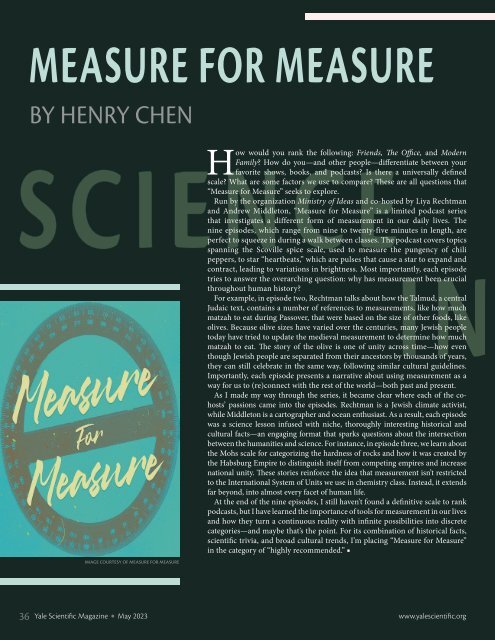YSM Issue 96.2
You also want an ePaper? Increase the reach of your titles
YUMPU automatically turns print PDFs into web optimized ePapers that Google loves.
MEASURE FOR MEASURE<br />
BY HENRY CHEN<br />
IMAGE COURTESY OF MEASURE FOR MEASURE<br />
SCIENCE<br />
How would you rank the following: Friends, The Office, and Modern<br />
IN<br />
Family? How do you—and other people—differentiate between your<br />
favorite shows, books, and podcasts? Is there a universally defined<br />
scale? What are some factors we use to compare? These are all questions that<br />
“Measure for Measure” seeks to explore.<br />
Run by the organization Ministry of Ideas and co-hosted by Liya Rechtman<br />
and Andrew Middleton, “Measure for Measure” is a limited podcast series<br />
that investigates a different form of measurement in our daily lives. The<br />
nine episodes, which range from nine to twenty-five minutes in length, are<br />
perfect to squeeze in during a walk between classes. The podcast covers topics<br />
spanning the Scoville spice scale, used to measure the pungency of chili<br />
peppers, to star “heartbeats,” which are pulses that cause a star to expand and<br />
contract, leading to variations in brightness. Most importantly, each episode<br />
tries to answer the overarching question: why has measurement been crucial<br />
throughout human history?<br />
For example, in episode two, Rechtman talks about how the Talmud, a central<br />
Judaic text, contains a number of references to measurements, like how much<br />
matzah to eat during Passover, that were based on the size of other foods, like<br />
olives. Because olive sizes have varied over the centuries, many Jewish people<br />
today have tried to update the medieval measurement to determine how much<br />
matzah to eat. The story of the olive is one of unity across time—how even<br />
though Jewish people are separated from their ancestors by thousands of years,<br />
they can still celebrate in the same way, following similar cultural guidelines.<br />
Importantly, each episode presents a narrative about using measurement as a<br />
way for us to (re)connect with the rest of the world—both past and present.<br />
As I made my way through the series, it became clear where each of the cohosts’<br />
passions came into the episodes. Rechtman is a Jewish climate activist,<br />
while Middleton is a cartographer and ocean enthusiast. As a result, each episode<br />
was a science lesson infused with niche, thoroughly interesting historical and<br />
cultural facts—an engaging format that sparks questions about the intersection<br />
between the humanities and science. For instance, in episode three, we learn about<br />
the Mohs scale for categorizing the hardness of rocks and how it was created by<br />
the Habsburg Empire to distinguish itself from competing empires and increase<br />
national unity. These stories reinforce the idea that measurement isn’t restricted<br />
to the International System of Units we use in chemistry class. Instead, it extends<br />
far beyond, into almost every facet of human life.<br />
At the end of the nine episodes, I still haven’t found a definitive scale to rank<br />
podcasts, but I have learned the importance of tools for measurement in our lives<br />
and how they turn a continuous reality with infinite possibilities into discrete<br />
categories—and maybe that’s the point. For its combination of historical facts,<br />
scientific trivia, and broad cultural trends, I’m placing “Measure for Measure”<br />
in the category of “highly recommended.” ■<br />
T<br />
36 Yale Scientific Magazine May 2023 www.yalescientific.org

















